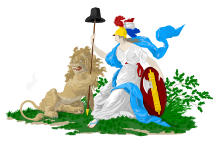Dutch Maiden

The Dutch Maiden (Dutch: Nederlandse Maagd) is a national personification of the Netherlands. She is typically depicted wearing a Roman garment and with a lion, the Leo Belgicus, by her side. In addition to the symbol of a national maiden, there were also symbolic provincial maidens and town maidens.
The Dutch Maiden has been used as a national symbol since the 16th century. During the

Initially carrying a
19th-century and later
During the French Revolutionary occupation, the short-lived Batavian Republic adopted the Dutch Maiden as its main symbol. The symbol was depicted on the upper left corner of the Batavian Republic's flag, with a lion at her feet. In one hand, she holds a shield with the Roman fasces and in the other a lance crowned with the cap of liberty.[3]
The Dutch Maiden continued to be used as a symbol after the foundation of the Kingdom of the Netherlands in 1815. She was integrated into a number of 19th century monuments, including:
- the statue in the centre of Plein 1813 in The Hague;[4]
- the statue commemorating the Battle of Heiligerlee,[5] and
- the statue on the Nieuwemarkt in Rotterdam.[6]
Maiden as a provincial or town symbol
Starting around the time of the Renaissance, it was not uncommon for a Dutch province to be symbolized by the image of a maiden, e.g. "the Maiden of Holland".
A "town maiden" (stedenmaagd) was sometimes used to symbolize a Dutch town, e.g. "the Maiden of Dordrecht".
Maiden of Dordrecht
On a relief on the 16th century
-
Dordrecht Maiden, 1596, stained glass window designed byJanskerk, Gouda.
-
Maiden of Dordrecht depicted in the Groothoofdspoort in Dordrecht in 1618.
In these symbols of Dordrecht, the heraldic shields are (clockwise from Geertruidenberg, the city shield on the "gate" of the garden) for the following towns: Geertruidenberg, Schoonhoven, Hoorn, Weesp, Leerdam, Naarden, Muiden, Medemblik, Grootebroek, Monnickendam, Enkhuizen, Asperen, Heusden, Schiedam and Vlaardingen.
Gallery
-
Dutch Maiden in thePhilips Galle
-
Same theme appearing in 1663, in Adriaen Matham's Counts of Holland series
-
Flags of the Batavian Republic.
-
Gérard de Lairesse, Allegory of the Freedom of Trade (glorifying the De Graefffamily' as the protector of the Republican state), 1672
-
Back of 1696 Leeuwarden silver half 3 guilder coin, with the Latin inscription "HANC TUEMUR, HAC NITIMUR" ("We protect her; she supports us").[7]
-
Classical and military dress, book frontispiece, c. 1670
-
Alternative classical style, at the national monument, Plein 1813, The Hague.
-
Statue inDutch Revolt.
-
Dutch Maiden in a political cartoon. Per the 1848 Dutch Constitution "The King is immune, the ministers are responsible".,[8]
-
Dutch Maiden on a design for the Golden Coach, by Nicolaas van der Waay, 1898.
-
Dutch Imperial Maiden (1916) with "Our most precious jewel", a necklace representing the Dutch East Indies.
References
- ^ "De Munt en Munteryebetreffende" (PDF) (in Dutch). Archived from the original (PDF) on 2011-07-24. Retrieved 2011-02-07.
- ^ de Vries, Hubert; van de Nederlanden, Wapens (1995). De historische ontwikkeling van de heraldische symbolen van Nederland, België, hun provincies en Luxemburg (in Dutch). Amsterdam: Uitgeverij Jan Mets. p. 183, note 9.
- ^ de Vries & van de Nederlanden 1995, pp. 38–39.
- ^ "Nationale Onafhankelijkheid". Van der Krogt sites (in Dutch).
- ^ "Adolf van Nassau". Van der Krogt sites (in Dutch).
- ^ "De Maagd van Holland". Van der Krogt sites (in Dutch).
- ^ It shows the Dutch Maiden holding a lance topped by a phrygian cap, left hand leaning on a bible and standing on an altar. From the collection of the Teylers Museum
- ^ Entitled Ons Schibboleth, printed in De Nederlandsche Spectator, 1866.
External links
 Media related to Netherlands Maiden at Wikimedia Commons
Media related to Netherlands Maiden at Wikimedia Commons







![Back of 1696 Leeuwarden silver half 3 guilder coin, with the Latin inscription "HANC TUEMUR, HAC NITIMUR" ("We protect her; she supports us").[7]](http://upload.wikimedia.org/wikipedia/commons/thumb/f/f3/Friesland%2C_zilveren_halve_driegulden%2C_1696%2C_Leeuwarden_%28back%29.JPG/120px-Friesland%2C_zilveren_halve_driegulden%2C_1696%2C_Leeuwarden_%28back%29.JPG)



![Dutch Maiden in a political cartoon. Per the 1848 Dutch Constitution "The King is immune, the ministers are responsible".,[8]](http://upload.wikimedia.org/wikipedia/commons/thumb/5/56/1866spotprentart53.jpg/95px-1866spotprentart53.jpg)

